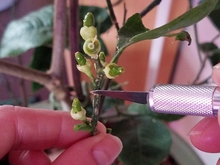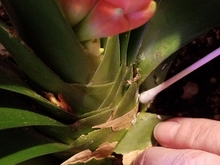The most effective ways to manage insects on plants

The content of this article 'Fruit gardening: What can I prune right now?' was prepared by The University of Minnesota Extension and has been revised and republished by FreshFruitPortal.com.
For the latest information, check the University of Minnesota's website here.
Many insect problems on indoor plants can be managed using nonchemical methods, particularly if the infestation is minor.

Carefully scrape scale without damaging the stem
Washing
- Wipe leaves with a damp paper towel, changing towels often to prevent spread.
- Spray small plants in a sink.
- Spray large plants in a shower.
Physically remove pests
- Handpick large pests such as earwigs, caterpillars, slugs and millipedes.
- Small numbers of scale insects can be removed using a fingernail file or something similar.
- Mealybugs can be removed using tweezers or a cotton swab dipped in alcohol.
- Some pests can be removed using a forceful spray of water.
- Repot with new potting soil to eliminate soil-borne pests. Use clean pots and wash soil off plant roots.

Remove mealybugs with a swab dipped in alcohol
Pruning
- Prune if a pest issue is isolated to a few leaves, stems or branches.
- When infestations are more widespread, prune the most severely infested plant parts. This makes it easier to manage pests on the remaining plant.
- In the case of severe infestations and depending on the type of plant, cutting it back may help eliminate pests.
- Watch new growth for signs of infestation.
Throw away or compost plant
- Necessary and economical if the plant is heavily infested and badly damaged.
- Avoids exposing other plants to the same pest problem.
Using pesticides for pest management
If you still have an insect problem after trying nonchemical methods, consider using a pesticide. There are a limited number of products available for indoor plants. They are sold at plant nurseries, garden centers, building supply stores and online.
They should contain one of the following active ingredients:
Pyrethrins
- No residual activity, must directly spray the insect to kill it.
- Effective against mealybugs, whiteflies, scales, thrips, aphids.
- Repeat applications usually necessary.
Potassium fatty acids (i.e. insecticidal soap)
- Sold specifically as an insecticide.
- Do not mix homemade soap products as this can burn plants.
- No residual activity, must directly spray the insect to kill it.
- Kills insects by smothering.
- Repeat applications are usually necessary.
- Effective against scales, aphids, thrips, spider mites, whiteflies.
Plant oil extracts
(canola, clove, sesame, cottonseed, garlic oils)
- Only kills when sprays cover the insects.
- Kills when insects are smothered.
- Repeat applications are usually necessary.
- Effective against scales, thrips, aphids, whiteflies, spider mites.
Neem oil
- Disrupts insect growth.
- Short to medium residual activity, lasts days or weeks.
- Repeat applications are usually necessary.
- Effective against whiteflies, thrips, aphids.
Bacillus thuringiensis, subspecies israelensis, strain AM 65-52
(e.g. Knock Out Gnats)
- Applied to the soil.
- Bacteria that specifically attack fungus gnat larvae.
- Not effective against fungus gnat adults.
- Available primarily online.
Imidacloprid
- Systemic, i.e. taken up and moved throughout the plant.
- Long residual activity, lasts months.
- CAUTION: Toxic to bees; do not use on bee attractive plants that are set outside during the summer.
- Effective against mealybugs, soft scales, aphids, whiteflies.
Precautions:
- Be sure the plant you are treating is listed on the product label.
- If you use a product that requires to be diluted with water, mix only as much as you expect to use in one day. Be sure to use it that day.
- Apply chemicals outdoors whenever possible.
- In cold weather, spray plants indoors in a well-ventilated area.
- To prevent secondary exposure from pesticides, enclose your plant in a plastic bag and seal shut.
- Cut a small hole in the side of the bag and insert your spray nozzle.
- Move the nozzle around to spray your plant thoroughly, especially under the leaves.
- Remove the spray nozzle and quickly cover the hole with duct tape.
- Keep it out of direct sun till dry after treatment.
- Never use any pesticide on a plant that is moisture-stressed. Water the soil a day or two before applying pesticides.
CAUTION: Mention of a pesticide or use of a pesticide label is for educational purposes only. Always follow the pesticide label directions attached to the pesticide container you are using. Remember, the label is the law.




































